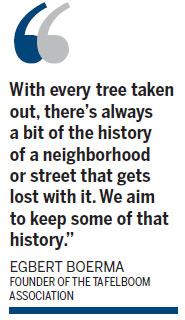Unique tables come with social 'history' of trees
Updated: 2012-07-23 08:04
By Agence France-Presse in Utrecht, the Netherlands (China Daily)
|
|||||||||||
They could have ended up as firewood or sawdust but felled trees in the Dutch city of Utrecht are getting a second life as one-of-a-kind tables, each with a booklet of stories by people who saw them grow.
 |
"With every tree taken out, there's always a bit of the history of a neighborhood or street that gets lost with it," Egbert Boerma of the historic city's Tafelboom (Dutch for "table tree") Association said. "We aim to keep some of that history," he said.
Like elsewhere, trees in this central university city of 300,000 residents are regularly taken down "victims" of urban expansion or simply too old or ill.
"When a tree is placed on the chopping list, we take a picture and gather information on its history, not only about the tree itself but also its surroundings," said Boerma, 33, a father of two young sons who founded the Tafelboom Association with two others in 2009.
"We have recovered one of the three oldest oak trees in the Netherlands. According to documents we consulted, this tree was planted in 1776," said Boerma, pointing at one of the 30 oak, beech, maple and a solitary hazel trunk stocked in the association's warehouse in Utrecht's outer suburbs.
In its three years, Tafelboom has retrieved 60 trees of which a dozen have been turned into tables that sell for around 1,700 euros ($2,086) each.
Some will stay close to home, bought by the city, including one that holds a place of honor at Utrecht's petting farm. Others were sold to companies or individuals.
"The trees in the city have a function for people they represent something," said Boerma.
City workers bring salvageable trunks to Tafelboom's warehouse where they are cut into planks and left to dry for a year or two. Each table, then, is designed to respect the "specifics of the wood", said Boerma.
In the meantime, the association organizes workshops with residents to record the tree's "history" or what role it may have played in their lives, compiling all in a booklet that is placed inside a drawer in the table.
"I remember sitting on a bench by this honey locust tree," reads one entry. "Nearby was a swing, a sandbox, a sliding board ... I felt peaceful there."
For Boerma, a former actor, the project not only offers a livelihood but a way to satisfy his love of a good story and reconnect with his rural roots.
Some customers come out of curiosity. "It's a coincidence, but I found a table made from a tree that stood on a street right near my elementary school. I remember it well," client Ruud Vocking said.
Others are drawn by the project's "green" side.
"What I found most interesting was the recycling," said Michael Jaggoe. "Instead of becoming waste, the wood is reused it finds a second function, a second life."
Tafelboom is looking to expand, already making children's building blocks and kitchen cutting boards at a more affordable 50 and 75 euros. They, too, come with their own little "history" book.
Today's Top News
President Xi confident in recovery from quake
H7N9 update: 104 cases, 21 deaths
Telecom workers restore links
Coal mine blast kills 18 in Jilin
Intl scholarship puts China on the map
More bird flu patients discharged
Gold loses sheen, but still a safe bet
US 'turns blind eye to human rights'
Hot Topics
Lunar probe , China growth forecasts, Emission rules get tougher, China seen through 'colored lens', International board,
Editor's Picks

|

|

|

|

|

|





